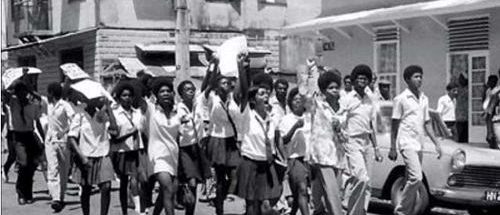Revisiting the Colour Line: Cycles of Resistance or Empowerment?
I have experienced tear gas twice in my life. First at a “black power march” in Port of Spain and secondly at that famous “Pele” football match in the Queen’s Park Oval.
These memories came flooding back to me on a recent site visit to the Queen’s Park Oval. It is amazing that the pungency of Tear Gas has never left my consciousness.
I was drawn to the 1970 revolution and I don’t know why! Was it because I lived that juxtaposition of poverty and plenty? Coming from behind the bridge, we used an out house while my school had water closets. Or was it because I challenged the fact that the banks appeared to be staffed only by lighter skinned young women? This was one of the complaints of the marchers in 1970. Or was it because when Ventures played hockey against Checkers, it looked like a white team versus a coloured team on the Princess Building grounds?
I was at a stage where although I sat next to a white Trinidadian in school and we are friends today, I was uncomfortable in the presence of white persons.
Of course I felt that my school friends were different. My school had very few “darkies”. In those days I had no opinion of girls of East Indian descent. I saw them as neither dark, coloured or negro. I don’t know how they were viewed.
School was a contrast of poverty and privilege, rich and poor, high status and commoner.
My sojourns to support the Black Power marches ended after the tear gas experience and I settled down to make the best of the opportunity for an education. I settled down as most of us do to allow the universe to unfold. However I kept a keen interest in anything associated with the Black Power movement. When Beverly Jones and Guy Harewood were killed I felt I had lost a sister and brother.
I met the late “Guy Harewood” through a friend who was at Queen’s Royal College. During the marches he would call me “smallie”. I saw this survivor of the Revolution recently and was deeply pained by how rough life has treated him. There is another survivor whom I met at a Gym in Central. We talked about the superficial but acknowledged the memories that were awakened. I remember the late Beverly Jones as a young woman appearing to be larger than life.
My “Black Power Kit” comprised denim jeans, black vest, a jacket, bandana and a lime.
There was some illusion that rubbing lime on your bandana before tying it over your nose and mouth would reduce the burning sensation of Tear Gas. I never had the chance to test this illusion because the Tear Gas was swift and powerful enough to confine me to my home whenever there was a march. My late mother’s mocking question echoed in my head: “Aye, Aye .. yuh not black powering today? … dey in de square yuh know!”
Years later, the international environment is punctuated by incidents of brutality against people of colour.
The schisms between black and white are once again intense and black people have to find a place in the world and indeed in Trinidad.
We are still marginalised and at the bottom of the rung. People still use latrines in many parts of the country. The conditions of today remind me of 1970. Our reality is being revisited daily. Is it that there were no lessons of 1970?
By Dennise Demming
Volunteer, TEDxPortofSpain
Photo: Students vent their feelings during the funeral procession for Basil Davis on 9 April 1970.
(Courtesy Embau Moheni/NJAC)
Taken from http://wired868.com/2016/04/08/remembering-basil-davis-the-1970-black-power-movements-first-martyr/


Your article coincided with my watching “Amazing Grace” at this very moment so I am compelled to thank you and be grateful for connected consciousness: going forward, facing the past, ” no distance will be too great.” I am full East Indian but was shunned by others in my race on few occasions simply because I looked more oriental.. it is quite ridiculous as India is steeped in various long bloodlines. I live in the USA now, it is hard to find a white person completely of European descent. I try to find a way to unity in a world ‘not’ exclusively exalting, over-extensively, the beauty of one race, which is important of course, just as it is important to have tradition, festivals with all cultures of the world. I would be lying if I said that I understood the partitioning of parts of the year specifically to commemorate only one race. I know it is important like Chinese new year. Celebration we take part in but is not the same as assigning parts of the year on a national level: It can overwhelm. I loved “Best Village” the show and thanks to slave revolt I had many years of Carnival where everyone was joined.